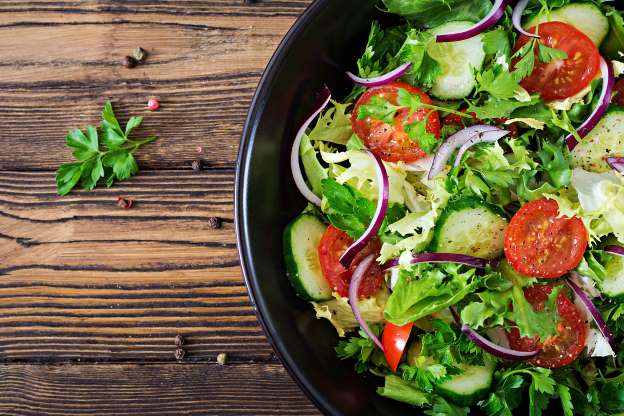Primal Diet
The dictionary definition of "Primal-" is that it means "old" or "ancient" and that it particularly refers to events or findings related to geologic times older than our own.
People in primitive ages lived off the land in whatever way they could as there were no factories to make food and no farmers growing crops. The lived off grass-fed meats they killed with spears and foraged for nuts, berries, fruits, vegetables that grew wild, tubers (plant roots) and greens picked from the ground. The exact tubers, vegetables, and fruits they lived off of may or may not be the same as those that exist today but what we have today are modern equivalents of what they age. They ate very little fat; what fat they ate was mainly saturated fats from meats.
What is there to eat on a primal diet?
The modern-day Primal Diet or "Stone Age diet" or "hunter-gatherer diet" takes what we have in modern times and uses only those foods that likely existed in that time and adapts it to a diet modern people can stick to. This eliminates all sugar, processed foods, and foods obtained from crops, such as wheat, corn, and barley. The basic premise of this diet is that, if we have the same genetic makeup as ancient man and they survived well without the modern diseases we currently are saddled with, shouldn't we benefit from eating what they ate?
The main things you eat in a "contemporary" Primal Diet" include grass-fed meats, vegetables, fruits, tubers (roots), fish and nuts. The main things you don't eat in a Primal Diet include refined sugar, processed oils, dairy products, salt, legumes, and grains. Believe it or not, you can find plenty to eat using this type of diet plan.
For the purposes of clarity, we will stick to the strictest form of Primal Diet which offers plenty of food choices for a healthy and tasty diet.
The goal of the Primal Diet is to mimic as closely as possible the diet of those people that had no access to domesticated animals and crops. They also had no access to processed oils such as corn oil, cottonseed oil, and palm oil. Realize, however, that we no longer have to forage for food and can eat fruits and vegetables that have been cultivated in farms or grown in orchards. Even the greens we eat come from large farms.
What is there to drink on a Primal Diet?
Primarily water in great quantities or tea made from herbs and leaves that would have been found in the coffers of ancient man. Alcohol and any fermented drinks should be avoided. Tea can be drunk warm or cold. In fact, there are no restrictions on whether or not the vegetables, fish or meat you eat is cooked or raw. This is because it was likely that ancient man had access to fire and had the ability to eat their meats and vegetables cooked over the fire. There are, however, those followers of a Primal Diet that believe that man's digestive system has not yet become adapted to cooked meats or cooked vegetables and only eats the raw variety.
When you eat a Primal Diet, it tends to be stronger on protein-containing foods. For the average Primal Diet, it is estimated that about 55-65 percent of the diet comes from animal-based or protein foods, while 35-45 percent of the diet comes from plant or carbohydrate-containing foods. Fat makes up very little of the diet. This is as opposed to a Western diet, which contains about 28-58 percent of the energy coming from fat.
Those who choose a Primal Diet believe we have begun to eat food that is not evolutionarily healthy for us and does not match the diet that our ancient ancestors foraged and hunted for. In order to become healthy again, we need to get back to our roots and choose foods that our bodies adapted to thousands of years ago. It means choosing the Primal Diet.
There are some who believe that being sedentary affects our genes and leads to things like cancer. Humans from today's time are comparatively less active and have less lean muscle mass than those who are hunter-gatherers. You need lean muscle mass to stave off type II diabetes. It is, in fact, believed that ancient man burned about a third of their caloric intake in physical activity, which is exactly what WHO recommends people get each day.
The dictionary definition of "Primal-" is that it means "old" or "ancient" and that it particularly refers to events or findings related to geologic times older than our own.
People in primitive ages lived off the land in whatever way they could as there were no factories to make food and no farmers growing crops. The lived off grass-fed meats they killed with spears and foraged for nuts, berries, fruits, vegetables that grew wild, tubers (plant roots) and greens picked from the ground. The exact tubers, vegetables, and fruits they lived off of may or may not be the same as those that exist today but what we have today are modern equivalents of what they age. They ate very little fat; what fat they ate was mainly saturated fats from meats.
What is there to eat on a primal diet?
The modern-day Primal Diet or "Stone Age diet" or "hunter-gatherer diet" takes what we have in modern times and uses only those foods that likely existed in that time and adapts it to a diet modern people can stick to. This eliminates all sugar, processed foods, and foods obtained from crops, such as wheat, corn, and barley. The basic premise of this diet is that, if we have the same genetic makeup as ancient man and they survived well without the modern diseases we currently are saddled with, shouldn't we benefit from eating what they ate?
The main things you eat in a "contemporary" Primal Diet" include grass-fed meats, vegetables, fruits, tubers (roots), fish and nuts. The main things you don't eat in a Primal Diet include refined sugar, processed oils, dairy products, salt, legumes, and grains. Believe it or not, you can find plenty to eat using this type of diet plan.
For the purposes of clarity, we will stick to the strictest form of Primal Diet which offers plenty of food choices for a healthy and tasty diet.
The goal of the Primal Diet is to mimic as closely as possible the diet of those people that had no access to domesticated animals and crops. They also had no access to processed oils such as corn oil, cottonseed oil, and palm oil. Realize, however, that we no longer have to forage for food and can eat fruits and vegetables that have been cultivated in farms or grown in orchards. Even the greens we eat come from large farms.
What is there to drink on a Primal Diet?
Primarily water in great quantities or tea made from herbs and leaves that would have been found in the coffers of ancient man. Alcohol and any fermented drinks should be avoided. Tea can be drunk warm or cold. In fact, there are no restrictions on whether or not the vegetables, fish or meat you eat is cooked or raw. This is because it was likely that ancient man had access to fire and had the ability to eat their meats and vegetables cooked over the fire. There are, however, those followers of a Primal Diet that believe that man's digestive system has not yet become adapted to cooked meats or cooked vegetables and only eats the raw variety.
When you eat a Primal Diet, it tends to be stronger on protein-containing foods. For the average Primal Diet, it is estimated that about 55-65 percent of the diet comes from animal-based or protein foods, while 35-45 percent of the diet comes from plant or carbohydrate-containing foods. Fat makes up very little of the diet. This is as opposed to a Western diet, which contains about 28-58 percent of the energy coming from fat.
Those who choose a Primal Diet believe we have begun to eat food that is not evolutionarily healthy for us and does not match the diet that our ancient ancestors foraged and hunted for. In order to become healthy again, we need to get back to our roots and choose foods that our bodies adapted to thousands of years ago. It means choosing the Primal Diet.
There are some who believe that being sedentary affects our genes and leads to things like cancer. Humans from today's time are comparatively less active and have less lean muscle mass than those who are hunter-gatherers. You need lean muscle mass to stave off type II diabetes. It is, in fact, believed that ancient man burned about a third of their caloric intake in physical activity, which is exactly what WHO recommends people get each day.







.jpg)

No comments:
Post a Comment
Please Dont Enter Any Spam Link in The Comment Box